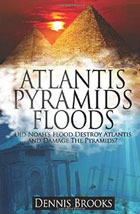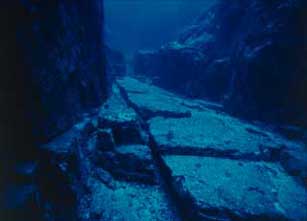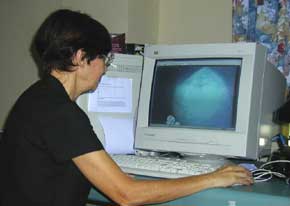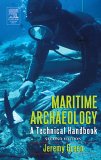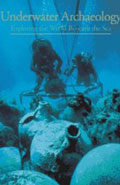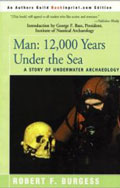|
But its greatest treasure-a 2,000-year-old underwater archaeological site-lies just a few feet offshore. Welcome to the port of the ancient Roman city of Olbia, which fell victim to a slow rise in Mediterranean waters, but is still open for visits from explorers equipped with a snorkel mask and pair of flippers. A collection of rectangular limestone blocks, some perfectly aligned, others scattered about on the seafloor, make up the watery remains of the dock of the city of Olbia, a fortified trading post founded by the Greeks in the 4th Century BC on the outskirts of the modern-day Riviera town of Hyeres. After the capture of nearby Marseille by Julius Caesar in 49 BC the region gradually came under the control of the Roman empire, which endowed Olbia with a port in the 1st Century AD.”
Most of the wrecks are Ancient Greek, Roman and Illyric ships, often loaded with treasures. After the collapse of the Albanian Communist regime of Enver Hoxha, many of the precious shipwreck sites, with vessels carrying gold coins and priceless artifacts, have totally disappeared or been looted. Illegal antiquities traffickers can make a fortune on the global market for ancient art and artifacts. Inside Albania an ancient amphora found in the sea can fetch 100 euros, but on the worldwide art and antiquities markets its price can skyrocket, reaching hundreds of thousands of euros.”
dating 3,500 years”
In northern Dalmatia, little was known about the Middle Bronze Age until archaeologists began underwater explorations several years ago. Well-preserved organic material trapped in thick marine growth layers has provided them with data they can very rarely obtain on land, enriching the knowledge about Pre-Liburnian communities living there about three millennia ago.”
It’s well worth a visit to their site to read the full story and see the underwater and other images of the finds – Ed.]
The wrecks lie in the small island archipelago of Fournoi, in the Eastern Aegean, and span a huge period from ancient Greece right through to the 20th century. Most are dated to the Greek, Roman and Byzantine eras. Although shipwrecks can be seen together in the Aegean, until now such a large number have not been found together. Experts say they weave an exciting tale of how ships full of cargo travelling through the Aegean, the Mediterranean and the Black Sea met their fate in sudden storms and surrounded by rocky cliffs in the area.”
It raelly is well worth a visit to their site to read the full story and see the image of the finds in situ – Ed.]
Unearthed in an expedition that was far from your ring-lost-in-the-sand search, the mesmerising shipwreck clasps intriguing artefacts dating back to 700 BC, knowing their origin to Phoenician traders. And for the first time on these islands, a selection of the artefacts – from what Heritage Malta describes as the oldest wreck ever found in this region – are on public display, at the Cittadella in Gozo.”
The pipeline from the deep-sea Leviathan gas field that is due to begin production late next year comes ashore near Dor Beach in northern Israel, a popular spot among Israeli sunbathers. It is also the site of the ancient port of Dor, where hidden in the seabed lie the vestiges of marine traders throughout the ages – from the Phoenicians to the Romans. To minimize damage to such relics, the Israel Antiquities Authority has been working over the past year with the Leviathan field’s operator, Texas-based Noble Energy. A team spent weeks scuba diving in the warm crystal clear water off the beach, dispersing silt to uncover ancient artifacts. A remote-operated robot was used for searches in deeper water. They found earthenware jugs, anchors and the remains of wrecked ships, setting new guidelines for similar future projects.”
St Thomas Island is 15km south of the Bulgarian seaside town of Sozopol and is a mere 0.012 square kilometres in size. Two places with low concentrations of fragmented ceramics were mapped. Several stone blocks with straight walls and traces of treatment, some a metre in length and width, were found here. The blocks are perpendicular to the underwater reef. This is probably a previously unknown fortification wall of the ancient Thracians.”
The ship, discovered during a joint expedition of the Institute of Archaeology of NAS of Ukraine and the Warsaw Institute of Archaeology, is believed to be one of the oldest of its kind discovered in the region. According to the head of the black sea international underwater archaeological expedition, Vyacheslav Gerasimov, it may have possibly sailed ancient trade routes to Olbia or Chersonesos. ‘This ship is one of the oldest known in the Northern black sea. The ship belonged to the ancient Greek mariners V century BC – the period of colonization of the Northern black sea, when was the first settlement of Olbia’, Gerasimov said.”
Now, after sitting at the bottom of the ocean for 310 years, the San José’s shipwreck has finally been officially identified, thanks to an analysis of the distinctive bronze cannons that sank with the ship. These bronze cannons still have ornate dolphins engraved on them, according to recordings made by the REMUS 6000, an autonomous underwater vehicle (AUV) that got within 30 feet (9.1 meters) of the shipwreck in 2015, according to Woods Hole Oceanographic Institution (WHOI). Although WHOI has known these details since 2015, only recently did affiliated agencies – Maritime Archaeology Consultants (MAC), Switzerland AG and the Colombian government – give the researchers permission to release the details to the public.”
The island in question was called Cyanida (or Kianida), and is featured on maps from the 15th century based on ‘Geography’ (also known as ‘Geographia’ or the ‘Cosmographia’), a work written ca. 150 AD by 2nd century AD Greco-Roman geographer Claudius Ptolemy. These include maps published in 1467 in the Reichenbach Monastery (today in Southern Germany) such as Ptolemy’s 9th European Map (Nona Europae Tabula) (featuring Dacia (Datia), Thrace (Thracia), and Upper and Lower Moesia) and Ptolemy’s 1st Asian Map (Tabula Asiae I), depicting Asia Minor / Anatolia. The maps in question are part of the collection of the National Library in Warsaw, Poland. In a paper published in 1982, Bulgarian geomorphologist Dinyo Kanev (1922 – 1997), a professor of geomorphology and cartography at Sofia University ‘St. Kliment Ohridski’, reveals geomorphic evidence about a sunken island located some 4 – 5 kilometers off the coast of the Black Sea near the spot of today’s border between Bulgaria and Turkey, close to Bulgaria’s Rezovo and Turkey’s Igneada.”
It’s hardly surprising that lands in that tectonically-active area will have sunk, and this is a good example of that. It’s well worth reading the full story and seeing the many images of the maps referred to – Ed.]
De Anda, director of the Great Maya Aquifer (GAM), research project of the National Institute of Anthropology and History (INAH) of Mexico, explained during a press conference that the site covers 248 cenotes, entrances to the submerged caves, and 198 archaeological objects have been found. Of these, 138 contexts are Mayan and the others belong to the preceramic period, which extends from the arrival of the first inhabitants from Asia more than 10,000 years ago until approximately 4,000 years ago. As for the Mayan vestiges, he pointed out that walls, passages and altars have been discovered, possibly dating from times prior to the occupation of the area by this culture. It also highlights a funerary context of Mayan origin, as evidenced by the presence of human remains and an associated ceramic offering.”
Well done archaeologist Guillermo de Anda, who heads up the team at the Great Maya Aquifer (GAM), research project. We wish them well with their reserches. It’s well worth reading the full story and seeing the amazing underwater image of the system – Ed.]
Florida Secretary of State Ken Detzner announced Wednesday that the Manasota Key Offshore archaeological site is on the continental shelf near Venice, preserved in what appears to have been a peat-bottomed freshwater pond. Reports of the site began in June 2016 when divers identified possible human skeletal material.”
Late Ice Age hunter-gatherers roamed the area that became the North Sea but very little evidence of their presence has been found. But sometimes the sea floor yields treasures that shed light on the period. This is a confirmation, the article says, of ‘the importance of continental shelves as archaeological archives’.”
This discovery is a major breakthrough for this area off the Netherlands, and it’s surprising much more hasn’t been looked for by marine archaeologists. Hopefully this discovery will change that. It’s well worth a visit to read the full story and see the image of the bison bone, and also to follow the link to the original
Maritime archaeologists made the discoveries just before Christmas while diving in the archipelago to take pictures and gather material for the planned museum, a spokesperson for the Swedish National Maritime Museums told The Local. Historic vessels are a fascinating, but not unusual, discovery in the Baltic Sea’s shipwreck graveyard (there are at least 100 intact ships on the Baltic seabed). The water is too brackish for shipworm, which means that a huge number of wooden ships have survived on the bottom of the sea with almost intact hulls for centuries.”
An extensive network of limestone caves housing Mayan artefacts is just now being explored by scientists from Mexico’s National Anthropology and History Institute (INAH). What INAH researchers have found is a remarkable underwater system, measuring more than 340km in length, which connects two previously known cenotes – Spanish for ‘giant sinkhole aquifers’ – near Tulum, in the state of Quintana Roo. Scuba diving in the immense tunnels lined with stalactites, researchers have found highly preserved ceramic vases from Mayan society which would have been used in funerals and during ritual sacrifices. They have also found intact human skulls, along with bones from elephants, giant sloths, bears, tigers and extinct species of horses, along with now-extinct plants. Investigators say the artefacts are well preserved because of the caves’ inaccessibility. Cenotes, known as dzonoot in Mayan, were a central part of the Mayan society and religion that flourished in what is now Mexico’s Yucatan, along with the Central American countries of Guatemala, Honduras and El Salvador”
The spectacular ruins are thought to be those of a fortress built by the Uratu civilisation which flourished in the Iron Age between the 9th and 6th centuries BC. The discovery was made by archaeologists from the Van Yüzüncü Yil University working with a team of divers. In an interview with Turkey’s newswire service Andalou Agency, underwater videographer and head of the diving team, Tahsin Ceylan explained that other divers and archaeologists familiar with the lake advised the team they were unlikely to find much in the water. But they eventually found that the remarkable ruins are part of an extensive site, which stretches roughly a kilometre. Despite being underwater for centuries, the height of the visible sections of the fortress’s remaining walls range between 10 and 13 feet high.”
The finds were discovered during underwater excavations carried out by a joint mission from the Ministry of Antiquities’ Underwater Archaeology Department and the European Institute of Underwater Archaeology in Abu Qir Bay and Alexandria’s eastern harbour. Mostafa Waziri, Secretary-General of the Supreme Council of Antiquities, told Ahram Online that the mission also uncovered a crystal Roman head probably depicting the Roman army commander Marc Antony and gold coins from the reign of Emperor Augustus.”
And the results from forensic tests on the latest skeleton to be excavated from the sands at the shipwreck site show the victim was in good health before he died, University of WA Centre for Forensic Anthropology associate professor Daniel Franklin says. The Batavia, a Dutch East India Company ship, was wrecked on Morning Reef near Beacon Island – 60km off modern Geraldton – in 1629. Of about 341 people aboard, most made it to nearby islands but more than 120, including women and children, were brutally killed during a mutiny.”
The corps of the Praetorian Guards were established more than two centuries after that battle, by Emperor Augustus. Praetorian helmets also sported a lion-shaped relief, and were sometimes adorned with real lion skin. The helmet’s dating is based, among other things, on pottery jars and other debris discovered on the sea floor at the site.”
An underwater archaeological study of the Ram Setu is likely to take off soon with Indian archaeological exploration experts scheduled to discuss the modalities with their Sri Lankan counterparts on the sidelines of the International Council of Monuments and Sites (ICOMOS) event on October 2-5 in Tanzania. The setu runs from Pamban Island near Rameshwaram in South India to Mannar Island off the northern coast of Sri Lanka in Indian Ocean. This will be a first of its kind project as no underwater exploration has so far been done to find out whether Ram Setu or the Adam’s Bridge is a myth or artificial phenomenon. In March this year, the Indian Council of Historical Research (ICHR) had announced to conduct an underwater exploration study on Ram Setu based on a proposal of Assam University, a central university.”
But excavations eventually showed that Troy was indeed a real place and this is now accepted as fact. It’s well worth a visit to read the full story at Hindustan Times, and
Managed by EEF Expeditions Limited, with the University of Southampton leading scientific investigations, the project has revealed an extensive collection of wrecks using the latest robotic laser scanning, acoustic and photogrammetric techniques. The oldest of the ships found date from the Classical period, around the fourth or fifth century BC. Vessels have also been discovered from the Roman, Byzantine and Ottoman periods, spanning two-and-a-half millennia. Together, they represent an unbroken pattern of trade, warfare and communication that reaches back into prehistory. Due to the anoxic (oxygen lacking) conditions of the Black Sea below a certain depth, some of the wrecks have survived in incredible condition.”
Managed by EEF Expeditions Limited, with the University of Southampton leading scientific investigations, the project has revealed an extensive collection of wrecks using the latest robotic laser scanning, acoustic and photogrammetric techniques. The oldest of the ships found date from the Classical period, around the fourth or fifth century BC. Vessels have also been discovered from the Roman, Byzantine and Ottoman periods, spanning two-and-a-half millennia. Together, they represent an unbroken pattern of trade, warfare and communication that reaches back into prehistory. Due to the anoxic (oxygen lacking) conditions of the Black Sea below a certain depth, some of the wrecks have survived in incredible condition.”
According to participants, nobody has seen or registered those ships before. One of the wrecks was found very recently. A submarine with dozens of cameras installed will be used to explore the ship, while scientists will look at the find on monitors. On Bulgarian National Television (BNT), Dr. Dragomir Grbov from the Center for Underwater Archeology in Sozopol said, one of the most important discoveries in underwater archaeology had been made. Grbov said, there was an antique ship which was very well preserved, almost in its entirety. It included ‘many elements that are completely unknown to science so far’.”
The underwater archaeological team used Remotely Operated Vehicles to find 60 wrecks dating back 2,500 years, and also galleys from the Roman, Byzantine and Ottoman empires. They had originally set off to investigate historic climate change along the Bulgarian coast but discovered the ships during underwater surveys. Because the Black Sea contains almost no oxygen, the finds are in excellent condition – even including intact rope on a Roman ship.”
The excavation that continues for the fifth year by the Greek Ephorate of Old Antiquities was conducted from July 8 to 27. Among other findings are pieces of furniture, coins and other personal possessions of the crew. Also pieces of a pulley, ropes and other metal objects from one of the ship’s masts. The ship, which was carrying antiquities plundered from the Parthenon by British diplomat Lord Elgin, was bound for England via Malta but sank at the entrance of the port of Avlemona southwest Kythera.”
Dr Jon Henderson, from the University of Nottingham, carried out a high-resolution survey of the underwater ruins of Port Royal. Once a haven for pirates to trade, drink and launch attacks, a large portion of the settlement was lost in a devastating earthquake in 1692. Experts have since been trying to record what lies beneath the surface so the city can be better protected. Dr Henderson has now used new technology to create a precise digital model of its ruins in three dimensions, with photo-realistic detail. His findings will be shown in a new documentary being broadcast on the National Geographic Channel on Wednesday (July 26).”
The new discoveries mean a total of 53 shipwrecks have now been identified at Fourni in an area of 17 square miles (44 square kilometers). In ancient times, the archipelago was a popular stop along trade routes in the Aegean Sea. Under normal conditions, the islands’ harbours were safe. But researchers think that with so many vessels passing through the area over thousands of years, several were bound to be lost in storms. Underwater archaeologists started exploring Fourni only in 2015, when a team from the Greek Ephorate of Underwater Antiquities and the RPM Nautical Foundation (a nonprofit archaeological research and education organization) located 22 shipwrecks. The divers went back to the site in 2016 and found an additional 23 wrecks.”
‘We have found church remains. It is in a basilica plan and has three naves’, Mustafa Zahin, an archaeology professor at Bursa Uluda University, told Hurriyet News. Plans are now underway to open an underwater museum to allow tourists to view the foundation of the church, which was found lying in 5-7 feet of water in Lake Iznik, in Bursa, Turkey. The ancient basilica was discovered by aerial photographs taken in 2014 during an inventory of historical and cultural artifacts.”
They were on board three ships belonging to the huge Spanish Armada, on their way under the orders of the King of Spain, Philip II, to invade England. But they hit stormy weather when they reached Ireland’s west and north coasts, and over 20 were wrecked. Just 300 survived of the men who were on the three ships. Some of the survivors were killed by English officers. Fionnbarr Moore is a senior archaeologist on the Underwater Archaeology Unit of the National Monuments Service, which was set up in 2000 and is working on a project to uncover items from the wreckage at the Streedagh site.”
After more than 10,000 items of gold and silver were recovered from the bottom of Minjiang River in Sichuan Province, archeologists confirmed Monday the tale of Zhang Xianzhong and his sunken treasure, dating back to the Ming Dynasty (1368-1644). Legend had it that in 1646, peasant leader Zhang Xianzhong was defeated by Ming Dynasty soldiers while attempting to transfer his large haul of treasure southward. About 1,000 boats loaded with money and assorted valuable were said to have sunk in the skirmish. But for centuries the story remained little more than a rumor with no reliable evidence.”
Gold coins dating to the destruction of the crusader bastion in 1291 C.E., when the Mamluk Sultan of Egypt stormed it in a struggle to wrest the Holy Land from the crusaders, were also found in the water by the archaeologists, led by Dr. Deborah Cvikel, Dr. Ehud Galili and Prof. Michal Artzy from Haifa University. Meanwhile, on land in Acre, an excavation led by Haifa University’s Prof. Adrian Boas has found the long-lost headquarters of the Teutonic Order on the eastern side of the city, outside the Ottoman walls. Beginning with the First Crusade in 1096 C.E. and continuing for two centuries, Christian armies crossed back and forth between Europe and the Middle East, vying against Muslim forces. Control over Jerusalem was a key issue.”
Underwater archaeologists who have been investigating the remains of a ship that sunk 2,600 years ago off the coast of Gela in southern Sicily recovered 47 lumps of the precious alloy earlier this month, along with a jar and two Corinthian helmets. The newly found ingots come in addition to the 39 orichalcum lumps that were originally recovered in 2015 from the same shipwreck. ‘The ship dates to the end the sixth century B.C.’, said Sebastiano Tusa, an archaeologist who serves as Sicily’s superintendent of the sea. ‘It was likely caught in a sudden storm and sunk just when it was about to enter the port.'”
A museum show of sumptuous treasures from a ninth-century shipwreck is being denounced by researchers, who say that commercial salvage of the artefacts irreversibly damaged the wreck’s scientific value. On 6 February, the Advisory Council on Underwater Archaeology sent a letter of opposition to the Asia Society, the non-profit group that is mounting the show of Chinese Tang-dynasty porcelains, gold vessels and other objects from the wreck at its New York City museum. Critics fear that the exhibition, slated to open on 7 March, will encourage exploitation of wrecks by for-profit firms. Museums that show salvaged treasures don’t intend to promote treasure-hunting, ‘but that’s the effect it has’, says Marco Meniketti, an archaeologist at San José State University in California who leads the advisory council.”
The 2,700-year-old sculpture found during examinations in a ship wreckage, which was unearthed last year in November, belonged to a Cypriot goddess. The works, carried out by Dokuz Eylül University (DEU) Marine Science and Technology Institute, unearthed the sculpture 43 meters under water, and is reported to date back to the archaic period. The institute’s Aegean Research and Application Center (EBAMER) Deputy Director and the head of the excavations, Associate Professor Harun Özdas, said the excavations were carried out with the permission of the Culture and Tourism Ministry and the support of the Development Ministry. He said they only found the lower half of the ceramic sculpture along with ceramic plates and amphoras.”
|
by
…
…
|
